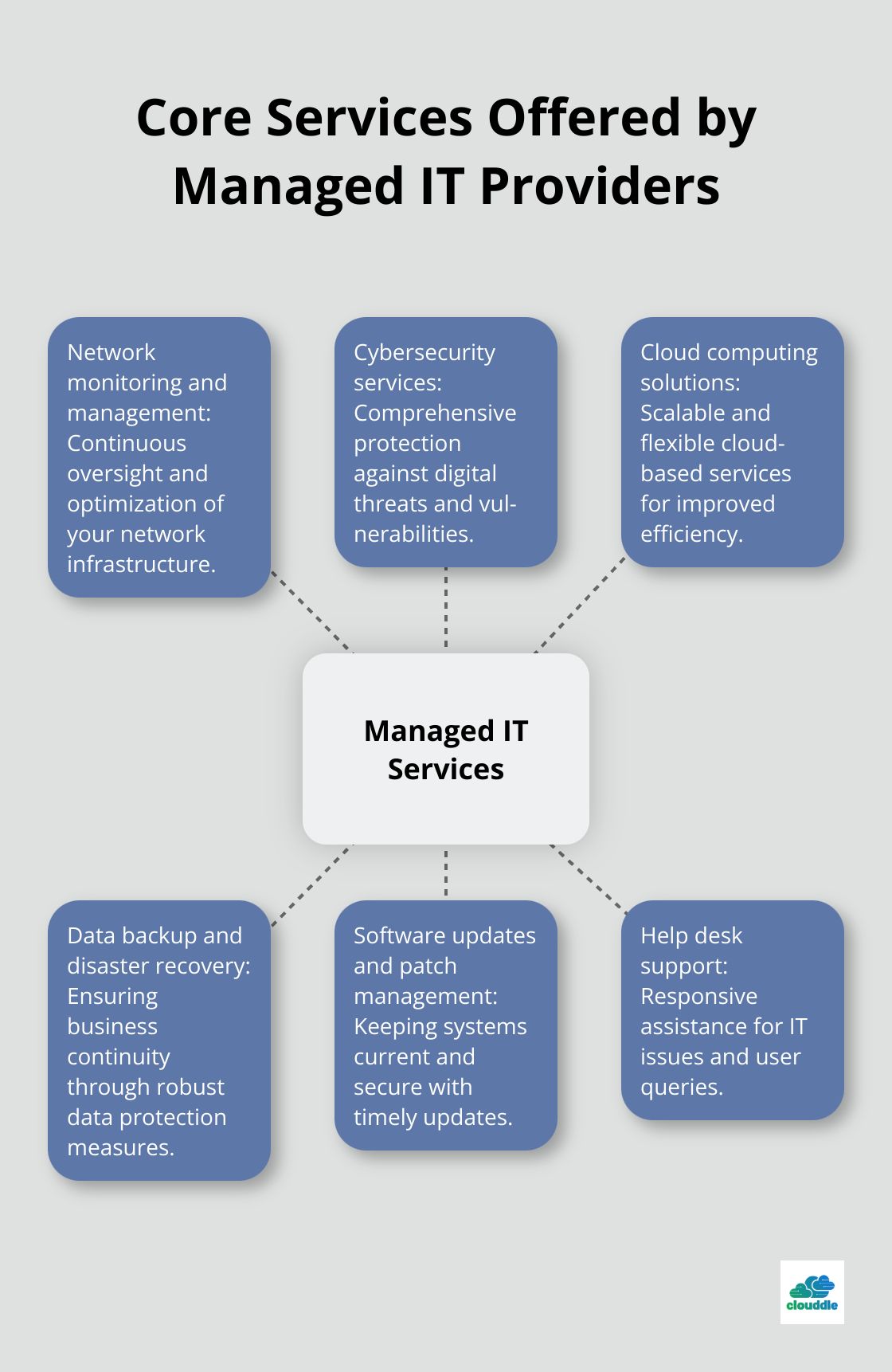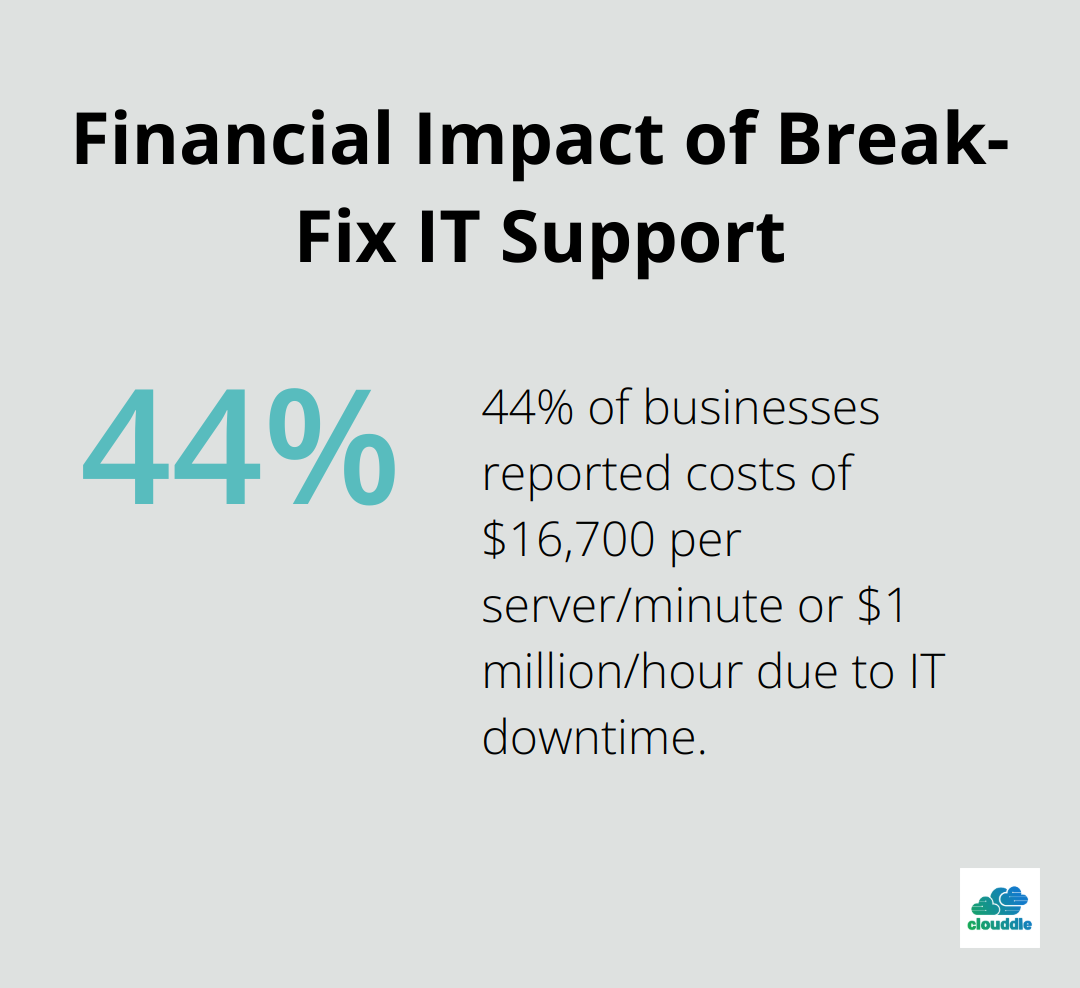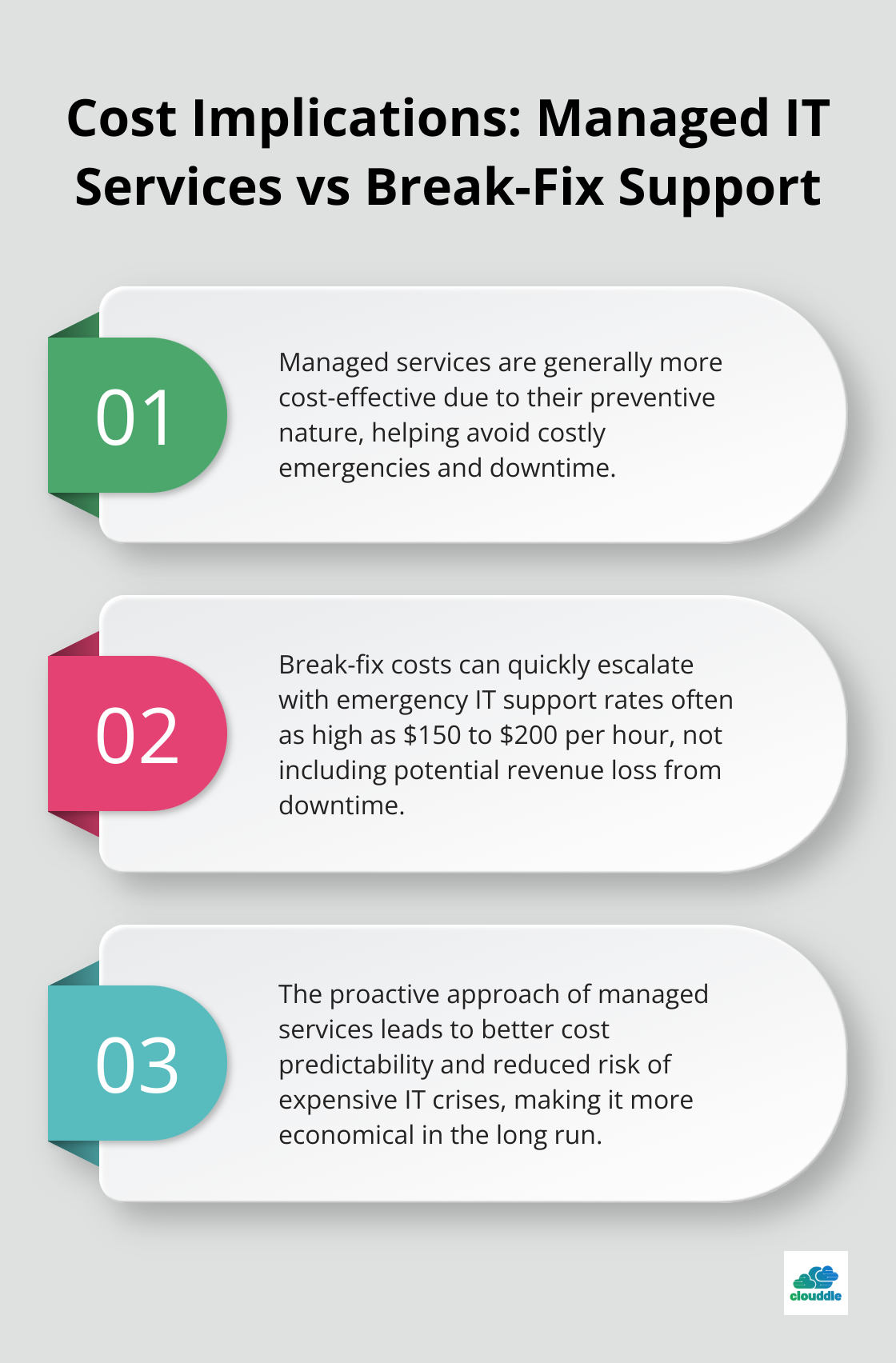At Clouddle, we often encounter businesses grappling with a crucial IT decision: managed IT services vs break-fix support.
This choice can significantly impact a company’s operational efficiency, security, and bottom line.
In this post, we’ll explore the key differences between these two IT support models and help you determine which approach aligns best with your business needs.
What Are Managed IT Services?
The Comprehensive Approach to IT Management
Managed IT services are comprehensive solutions provided by an external organization to handle a company’s IT needs. This model transforms businesses by providing proactive, continuous IT support and management.
The Essence of Managed IT Services
Managed IT services involve the outsourcing of IT operations to a specialized provider. This provider assumes responsibility for monitoring, managing, and resolving IT issues for your business. Unlike traditional IT support that reacts to problems, managed services adopt a proactive stance, continuously monitoring systems to prevent issues before they affect operations.
Proactive IT Management: A Game-Changer
The proactive nature of managed IT services revolutionizes business operations. This approach can lead to cost reductions resulting from the prevention of expensive downtime and quick resolution of issues when they occur.
Core Services Offered by Managed IT Providers
Managed IT providers offer a wide array of services tailored to meet diverse business needs:

- Network monitoring and management
- Cybersecurity services
- Cloud computing solutions
- Data backup and disaster recovery
- Software updates and patch management
- Help desk support
The Transformation of Business Operations
Managed IT services allow businesses to concentrate on their core competencies while experts handle the complexities of IT management.
Companies that utilize managed IT services experience fewer disruptions, enhanced security, and improved overall performance of their IT infrastructure. This enables them to allocate more resources to strategic initiatives that drive growth and innovation.
The next chapter will explore the alternative to managed IT services: the break-fix IT support model. Understanding both approaches will help you make an informed decision about which model best suits your business needs.
What Is Break-Fix IT Support?
The Reactive Approach to IT Management
Break-fix IT support represents a reactive approach to managing technology issues. This model operates on an as-needed basis, where businesses contact IT professionals only when their systems malfunction.
Understanding the Break-Fix Model
In a break-fix scenario, IT problems receive attention only after they occur. This can result in significant downtime and unexpected costs. Per-outage losses can range from at least $10,000 to over $1,000,000, underscoring the potential risks of relying solely on reactive IT support.
Scenarios Where Break-Fix Might Work
Despite its drawbacks, break-fix support can suit certain situations:
- Small businesses with limited IT needs
- Organizations with capable in-house IT staff
- Companies with simple, low-maintenance IT infrastructures
However, as organizations grow and their IT infrastructure becomes more complex, the limitations of break-fix support become apparent.
The Financial Impact of Break-Fix
While break-fix might appear cheaper initially, it often leads to higher long-term costs. Emergency IT services typically come with premium rates.

About 44% of businesses polled put costs at $16,700 per server/per minute or $1 million an hour, highlighting the financial risks associated with a reactive IT approach.
The Shift Towards Proactive Solutions
Many businesses transition from break-fix to managed IT services after experiencing the unpredictability and hidden costs of the reactive model. Proactive IT solutions prevent many issues before they impact operations, providing better value and peace of mind for businesses across various industries.
As we move forward, it’s important to compare these two IT support models side by side. The next section will explore the key differences between managed IT services and break-fix support, helping you determine which approach aligns best with your business needs.
Which Model Delivers Better Value?
At Clouddle, we’ve observed the impact of choosing between managed IT services and break-fix support on businesses. Let’s examine the key factors that differentiate these models and determine which provides better value.
Cost Implications
Break-fix might appear cheaper initially, but it often results in higher long-term costs.

Managed services are generally more cost-effective compared to break/fix solutions. This significant difference stems from the preventive nature of managed services, which helps avoid costly emergencies and downtime.
In contrast, break-fix costs can quickly escalate. Emergency IT support often comes with premium rates (sometimes as high as $150 to $200 per hour). Add to this the potential revenue loss from downtime, and the true cost of break-fix becomes apparent.
Business Continuity and Downtime
Downtime is a critical factor in choosing an IT support model. According to a 2014 study by Gartner, the average cost of IT downtime is $5,600 per minute. Managed IT services significantly reduce this risk through proactive monitoring and maintenance.
Scalability and Flexibility
As businesses grow, their IT needs evolve. Managed IT services offer scalability that break-fix cannot match. With managed services, businesses can easily add or remove services as needed, ensuring their IT infrastructure grows in tandem with their operations.
This flexibility proves particularly important for seasonal businesses or those experiencing rapid growth.
Security and Compliance
In today’s digital landscape, cybersecurity is non-negotiable. Managed IT services provide comprehensive security measures, including regular updates, patch management, and proactive threat detection.
Compliance is another area where managed services excel. With constantly evolving regulations like GDPR and HIPAA, staying compliant can challenge businesses. Managed service providers stay up-to-date with these regulations, ensuring businesses remain compliant and avoid costly penalties.
Final Thoughts
Managed IT services vs break-fix support presents a clear choice for businesses. Managed services offer proactive monitoring, regular maintenance, and comprehensive security measures. This approach reduces downtime, enhances business continuity, and provides better cost predictability.
Break-fix support might appeal due to its pay-as-you-go nature. However, it often leads to higher long-term costs, increased downtime, and potential security vulnerabilities. The reactive nature of break-fix can expose businesses to significant risks and unexpected expenses.
At Clouddle, we provide managed IT solutions tailored to various industries. Our Network as a Service (NaaS) combines networking, entertainment, and security (empowering businesses to thrive in today’s digital landscape). We ensure your IT infrastructure supports your business goals effectively.


